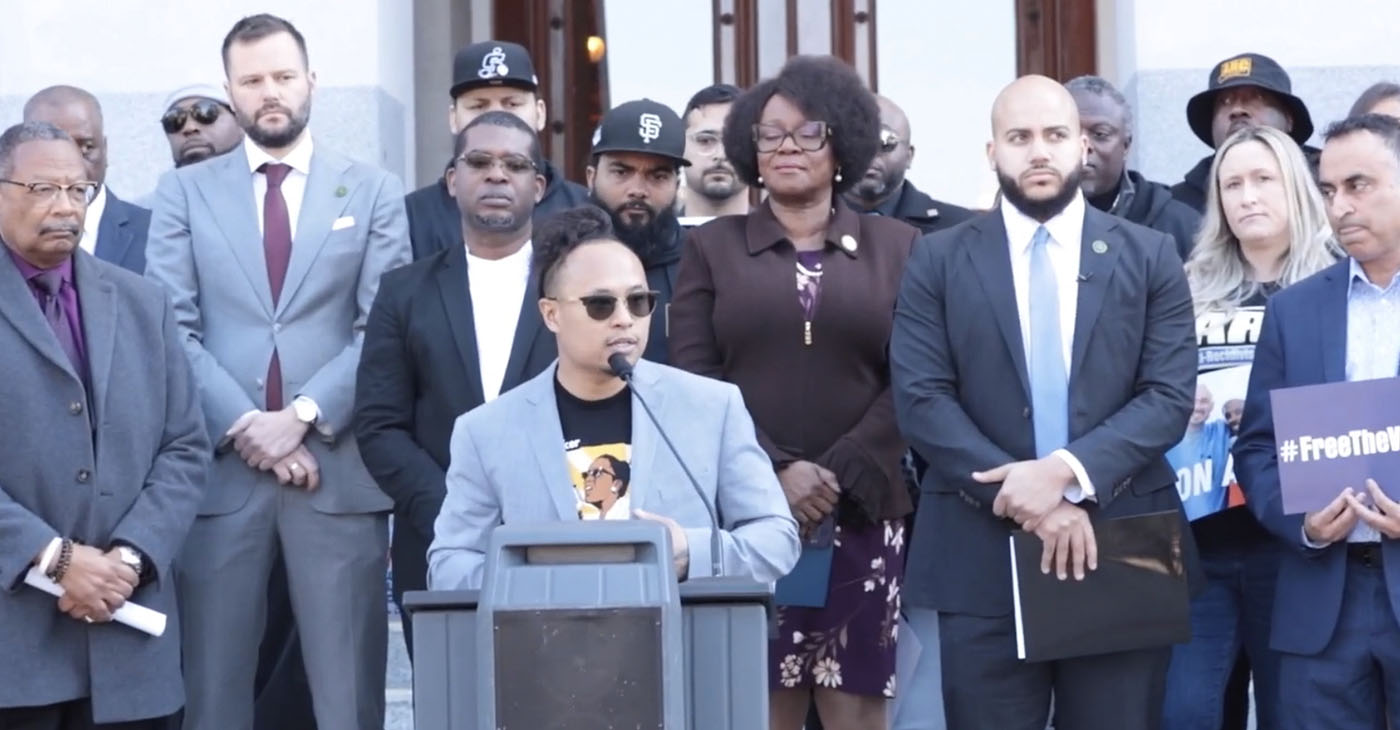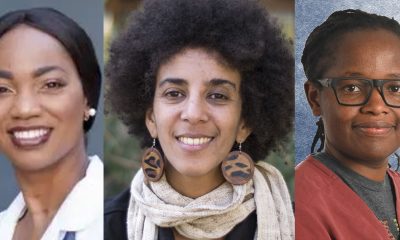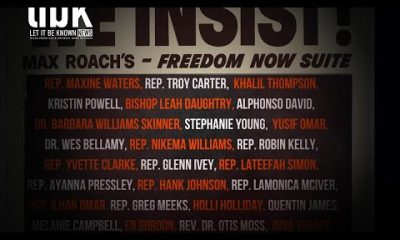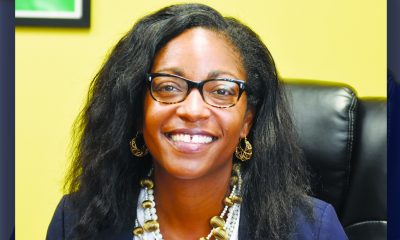Activism
Lawmakers Push Bill to Grant Prisoners Right to Vote
Last week, Assemblymember Isaac Bryan (D-Los Angeles) the chair of the Assembly’s Committee on Elections introduced Assembly Constitutional Amendment 4 (ACA-4). The legislation proposes amending the California Constitution to allow felons serving time in state and federal prisons to vote.

By Maxim Elramsisy
California Black Media
Last week, Assemblymember Isaac Bryan (D-Los Angeles) the chair of the Assembly’s Committee on Elections introduced Assembly Constitutional Amendment 4 (ACA-4). The legislation proposes amending the California Constitution to allow felons serving time in state and federal prisons to vote.
Proposition 17, approved in 2020 by California voters, enabled persons convicted of felonies on parole to vote.
If the bill passes the Assembly and Senate, and the governor approves it, voters in California could vote to join Vermont, Maine, and Washington, D.C. in allowing incarcerated individuals to vote.
“After the 13th Amendment liberated the slaves, we started to see different types of voter disenfranchisement occurring,” Bryan explained in an interview with California Black Media (CBM).
“We saw Black codes, we saw Jim Crow, poll taxes, literacy tests, felony disenfranchisement, becoming more commonplace in statewide constitutions and so it’s through that legacy that we’ve been trying to roll back all of these years and make sure that our democracy is inclusive of everybody,” Bryan commented on the systemic discrimination and disenfranchisement African Americans have endured over centuries.
Lawmakers opposing the legislation say allowing incarcerated felons to vote is a slap in the face to victims of the crimes they committed.
“I believe that it discounts the impact that this will have on people who have suffered being a victim of a very violent offense,” Assemblymember Tom Lackey (R-Palmdale) told CBM.
“Part of rehabilitation is going through a process of recognizing the seriousness of what has been done, and I think when we allow someone to exercise the most sacred privilege that we have in this country, that people have died so that we can exercise that privilege, that is an affront against those who have suffered ill, and a lot of times eternal pain,” Lackey said.
Responding to Lackey’s objection, Bryan said, “That’s like saying allowing incarcerated persons to breathe is an affront to their victims, allowing incarcerated persons to drink water, allowing incarcerated persons to hold conversations with one another.”
“There is no reason that that should be coupled with disenfranchisement and the expelling of individuals as citizens of this country.”
“There’s a difference between suspending a privilege and dehumanizing someone,” Lackey said. “Certainly no one expects someone to go through inappropriate suffering. That is not part of justice. That’s not part of our judicial process.”
David Liamsi Cruz, an advocate from Initiate Justice, was released in September after serving 13 years in prison.
“One problem that I constantly came across was that people serving their sentences alongside me felt that they didn’t have the means to improve their environment that controlled their lives or to contribute to their families’ wellness outside. Despite what many people assume, people in prison care about the same political issues that we outside do,” Cruz said.
“Those who were willing to become civically engaged with me were diligent in their work, they even brought me bill ideas that could have solved issues that were longstanding in their communities. I was honored to witness their passion for change, for an opportunity to grow, and to contribute to something way bigger than themselves. Even though I am home [from] prison now, I have not forgotten the ten thousand voices of people who are still inside and have so much to contribute. I want their voices to be heard.”
Supporters of the plan say that reducing recidivism — or the reincarceration of persons less than three years after they are released from prison — is one of the primary benefits of this plan.
“We already know a lot of the facts, and the facts are that the more someone is engaged in their democracy, they are 50% less likely to reoffend,” said Assemblymember Ash Kalra (D-San Jose) who is a co-sponsor of the bill.
“So, if we already know this, then the policy not allowing those who are incarcerated to vote has nothing to do with public safety.”
Kalra said when he was a public defender it was “plain as day” to see who was given second chances.
“Those who were given probation versus prison, and it was so connected to race and class and the same communities who have been fighting to be free since the inception, and before the inception of this nation,” he said.
Another concern is the ability for those who are incarcerated to hold public officials accountable. “Those who are incarcerated and their families are some of the most educated people in our state, far more educated than the average voter,” said Kalra. “And they will hold us accountable, and maybe that’s what people are afraid of. They don’t want that accountability from those who are suffering the most from decisions that are made traditionally in [the Capital].”
The legislation is backed by a coalition of lawmakers, including California Legislative Black Caucus members — Assemblymembers Lori Wilson (D–Suisun City), Reggie Jones-Sawyer (D-Los Angeles), Tina McKinnor (D–Inglewood), Mia Bonta (D-Oakland), Dr. Akilah Weber (D–San Diego) and Senators Steven Bradford (D-Inglewood) and Lola Smallwood Cuevas (D–Ladera Heights).
“There was a time where women couldn’t vote,” Jones-Sawyer said at the press conference held last week to announce the bill. “There was a time when African Americans couldn’t vote, and just recently we tried to get slavery out of the California state constitution and it failed, because of Democrats.”
“An American citizen’s right to vote is the most powerful right in our nation,” McKinnor said. “Let’s be clear, an incarcerated American citizen is an American citizen, and no law should ever restrict an American citizen’s right to vote. Too many Americans have died, too many Americans have sacrificed, too many Americans have been denied the right to vote for too long.”
Lackey and others who oppose the legislation, however, insist that denying a felon to vote is appropriate punishment.
“There has to be a period of reflection and a period of suspension of certain what I would call privileges or rights in order for the judicial process to be effective,” Lackey said to CBM.
Bryan said the protection of citizens’ rights is paramount.
“There are some basic human rights, and then there are some basic American rights that have to be preserved, even in the systems of accountability,” he emphasized.
Activism
OPINION: Your Voice and Vote Impact the Quality of Your Health Care
One of the most dangerous developments we’re seeing now? Deep federal cuts are being proposed to Medicaid, the life-saving health insurance program that covers nearly 80 million lower-income individuals nationwide. That is approximately 15 million Californians and about 1 million of the state’s nearly 3 million Black Californians who are at risk of losing their healthcare.

By Rhonda M. Smith, Special to California Black Media Partners
Shortly after last year’s election, I hopped into a Lyft and struck up a conversation with the driver. As we talked, the topic inevitably turned to politics. He confidently told me that he didn’t vote — not because he supported Donald Trump, but because he didn’t like Kamala Harris’ résumé. When I asked what exactly he didn’t like, he couldn’t specifically articulate his dislike or point to anything specific. In his words, he “just didn’t like her résumé.”
That moment really hit hard for me. As a Black woman, I’ve lived through enough election cycles to recognize how often uncertainty, misinformation, or political apathy keep people from voting, especially Black voters whose voices are historically left out of the conversation and whose health, economic security, and opportunities are directly impacted by the individual elected to office, and the legislative branches and political parties that push forth their agenda.
That conversation with the Lyft driver reflects a troubling surge in fear-driven politics across our country. We’ve seen White House executive orders gut federal programs meant to help our most vulnerable populations and policies that systematically exclude or harm Black and underserved communities.
One of the most dangerous developments we’re seeing now? Deep federal cuts are being proposed to Medicaid, the life-saving health insurance program that covers nearly 80 million lower-income individuals nationwide. That is approximately 15 million Californians and about 1 million of the state’s nearly 3 million Black Californians who are at risk of losing their healthcare.
Medicaid, called Medi-Cal in California, doesn’t just cover care. It protects individuals and families from medical debt, keeps rural hospitals open, creates jobs, and helps our communities thrive. Simply put; Medicaid is a lifeline for 1 in 5 Black Americans. For many, it’s the only thing standing between them and a medical emergency they can’t afford, especially with the skyrocketing costs of health care. The proposed cuts mean up to 7.2 million Black Americans could lose their healthcare coverage, making it harder for them to receive timely, life-saving care. Cuts to Medicaid would also result in fewer prenatal visits, delayed cancer screenings, unfilled prescriptions, and closures of community clinics. When healthcare is inaccessible or unaffordable, it doesn’t just harm individuals, it weakens entire communities and widens inequities.
The reality is Black Americans already face disproportionately higher rates of poorer health outcomes. Our life expectancy is nearly five years shorter in comparison to White Americans. Black pregnant people are 3.6 times more likely to die during pregnancy or postpartum than their white counterparts.
These policies don’t happen in a vacuum. They are determined by who holds power and who shows up to vote. Showing up amplifies our voices. Taking action and exercising our right to vote is how we express our power.
I urge you to start today. Call your representatives, on both sides of the aisle, and demand they protect Medicaid (Medi-Cal), the Affordable Care Act (Covered CA), and access to food assistance programs, maternal health resources, mental health services, and protect our basic freedoms and human rights. Stay informed, talk to your neighbors and register to vote.
About the Author
Rhonda M. Smith is the Executive Director of the California Black Health Network, a statewide nonprofit dedicated to advancing health equity for all Black Californians.
Activism
OPINION: Supreme Court Case Highlights Clash Between Parental Rights and Progressive Indoctrination
At the center of this controversy are some parents from Montgomery County in Maryland, who assert a fundamental principle: the right to shield their children from exposure to sexual content that is inappropriate for their age, while also steering their moral and ethical upbringing in alignment with their faith. The local school board decided to introduce a curriculum that includes LGBTQ+ themes — often embracing controversial discussions of human sexuality and gender identity.

By Craig J. DeLuz, Special to California Black Media Partners
In America’s schools, the tension between parental rights and learning curricula has created a contentious battlefield.
In this debate, it is essential to recognize that parents are, first and foremost, their children’s primary educators. When they send their children to school — public or private — they do not surrender their rights or responsibilities. Yet, the education establishment has been increasingly encroaching on this vital paradigm.
A case recently argued before the Supreme Court regarding Maryland parents’ rights to opt out of lessons that infringe upon their religious beliefs epitomizes this growing conflict. This case, Mahmoud v. Taylor, is not simply about retreating from progressive educational mandates. It is fundamentally a defense of First Amendment rights, a defense of parents’ rights to be parents.
At the center of this controversy are some parents from Montgomery County in Maryland, who assert a fundamental principle: the right to shield their children from exposure to sexual content that is inappropriate for their age, while also steering their moral and ethical upbringing in alignment with their faith. The local school board decided to introduce a curriculum that includes LGBTQ+ themes, often embracing controversial discussions of human sexuality and gender identity. The parents argue that the subject matter is age-inappropriate, and the school board does not give parents the option to withdraw their children when those lessons are taught.
This case raises profound questions about the role of public education in a democratic society. In their fervent quest for inclusivity, some educators seem to have overlooked an essential truth: that the promotion of inclusivity should never infringe upon parental rights and the deeply held convictions that guide families of different faith backgrounds.
This matter goes well beyond mere exposure. It veers into indoctrination when children are repeatedly confronted with concepts that clash with their family values.
“I don’t think anybody can read that and say: well, this is just telling children that there are occasions when men marry other men,” noted Justice Samuel Alito. “It has a clear moral message, and it may be a good message. It’s just a message that a lot of religious people disagree with.”
Justice Amy Coney Barrett raised a crucial point, noting that it is one thing to merely expose students to diverse ideas; it is quite another to present certain viewpoints as indisputable truths. By framing an ideology with the certainty of “this is the right view of the world,” educators risk indoctrination rather than enlightenment. This distinction is not merely academic; it speaks to the very essence of cultivating a truly informed citizenry.
Even Justice Elena Kagan expressed concern regarding the exposure of young children to certain materials in Montgomery County.
“I, too, was struck by these young kids’ picture books and, on matters concerning sexuality, I suspect there are a lot of non-religious parents who weren’t all that thrilled about this,” she said.
Justice John Roberts aptly questioned the practicality of expecting young children to compartmentalize their beliefs in the classroom.
“It is unreasonable to expect five-year-olds, still forming their worldviews, to reconcile lessons that conflict fundamentally with the teachings they receive at home,” he said.
As was noted in my previous commentary, “The Hidden Truth In The Battle Over Books In American Schools”, what lies at the heart of these debates is a moral disconnect between the values held by the majority of Americans and those promoted by the educational establishment. While the majority rightly argue that material containing controversial content of a sexual nature should have no place in our children’s classrooms, the education establishment continues to tout the necessity of exposing children to such content under the guise of inclusivity. This disregards the legitimate values held by the wider community.
Highlighted in this case that is before the Supreme Court is a crucial truth: parents must resolutely maintain their right to direct their children’s education, according to their values. This struggle is not simply a skirmish; it reflects a broader movement aimed at reshaping education by privileging a state-sanctioned narrative while marginalizing dissenting voices.
It is imperative that we assert, without hesitation, that parents are — and must remain — the primary educators of their children.
When parents enroll a child in a school, it should in no way be interpreted as a relinquishment of parental authority or the moral guidance essential to their upbringing. We must stand firm in defending parental rights against the encroaching ideologies of the education establishment.
About the Author
Craig J. DeLuz has almost 30 years of experience in public policy and advocacy. He has served as a member of The Robla School District Board of Trustees for over 20 years. He also currently hosts a daily news and commentary show called “The RUNDOWN.” You can follow him on X at @CraigDeLuz.
Activism
Newsom, Pelosi Welcome Election of First American Pope; Call for Unity and Compassion
“In his first address, he reminded us that God loves each and every person,” said Newsom. “We trust that he will shepherd us through the best of the Church’s teachings: to respect human dignity, care for the poor, and wish for the common good of us all.” Newsom also expressed hope that the pontiff’s leadership would serve as a unifying force in a time of global instability.

By Bo Tefu, California Black Media
Gov. Gavin Newsom and First Partner Jennifer Siebel Newsom on May 8 issued a statement congratulating Pope Leo XIV on his historic election as the first American to lead the Catholic Church.
The announcement has drawn widespread reaction from U.S. leaders, including former House Speaker Nancy Pelosi, who called the moment spiritually significant and aligned with the values of service and social justice.
In their statement, the Newsoms expressed hope that the newly elected pope would guide the Church with a focus on compassion, dignity, and care for the most vulnerable. Newsom said he and the First Partner joined others around the world in celebrating the milestone and were encouraged by the pope’s first message.
“In his first address, he reminded us that God loves each and every person,” said Newsom. “We trust that he will shepherd us through the best of the Church’s teachings: to respect human dignity, care for the poor, and wish for the common good of us all.”
Newsom also expressed hope that the pontiff’s leadership would serve as a unifying force in a time of global instability.
“May he remind us that our better angels are not far away — they’re always within us, waiting to be heard,” he said.
Pelosi, a devout Catholic, also welcomed the pope’s election and noted his symbolic connection to earlier church leaders who championed workers’ rights and social equality.
“It is heartening that His Holiness continued the blessing that Pope Francis gave on Easter Sunday: ‘God loves everyone. Evil will not prevail,’” said Pelosi.
-

 Activism4 weeks ago
Activism4 weeks agoAI Is Reshaping Black Healthcare: Promise, Peril, and the Push for Improved Results in California
-

 Activism4 weeks ago
Activism4 weeks agoBarbara Lee Accepts Victory With “Responsibility, Humility and Love”
-

 Activism4 weeks ago
Activism4 weeks agoESSAY: Technology and Medicine, a Primary Care Point of View
-

 Activism4 weeks ago
Activism4 weeks agoNewsom Fights Back as AmeriCorps Shutdown Threatens Vital Services in Black Communities
-

 Activism4 weeks ago
Activism4 weeks agoFaces Around the Bay: Author Karen Lewis Took the ‘Detour to Straight Street’
-

 Arts and Culture4 weeks ago
Arts and Culture4 weeks agoBOOK REVIEW: Love, Rita: An American Story of Sisterhood, Joy, Loss, and Legacy
-

 #NNPA BlackPress4 weeks ago
#NNPA BlackPress4 weeks agoThe RESISTANCE – FREEDOM NOW
-

 Alameda County4 weeks ago
Alameda County4 weeks agoOUSD Supt. Chief Kyla Johnson-Trammell to Step Down on July 1














































